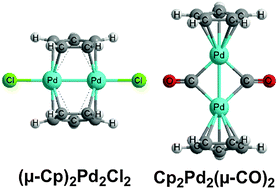Coaxial versus perpendicular structures for a range of binuclear cyclopentadienylpalladium derivatives†
Abstract
Binuclear palladium complexes of planar

Maintenance work is planned for Wednesday 1st May 2024 from 9:00am to 11:00am (BST).
During this time, the performance of our website may be affected - searches may run slowly and some pages may be temporarily unavailable. If this happens, please try refreshing your web browser or try waiting two to three minutes before trying again.
We apologise for any inconvenience this might cause and thank you for your patience.
* Corresponding authors
a
Key Laboratory of Cluster Science Ministry of Education of China, School of Chemistry, Beijing Institute of Technology, Beijing 100081, P. R. China
E-mail:
zhangxiuhui@bit.edu.cn
b State Key Laboratory of Explosion Science and Technology, Beijing Institute of Technology, Beijing 100081, P. R. China
c MOE Key Laboratory of Theoretical Chemistry of Environment, Center for Computational Quantum Chemistry, South China Normal University, Guangzhou 510006, P. R. China
d Center for Computational Quantum Chemistry, School of Chemistry and Environment, South China Normal University, Guangzhou 510631, P. R. China
e
Department of Chemistry and Center for Computational Chemistry, University of Georgia, Athens, Georgia 30606, USA
E-mail:
rbking@uga.edu
Binuclear palladium complexes of planar

 Please wait while we load your content...
Something went wrong. Try again?
Please wait while we load your content...
Something went wrong. Try again?
A. Peng, X. Zhang, Q. Li, R. B. King and H. F. Schaefer III, New J. Chem., 2013, 37, 775 DOI: 10.1039/C2NJ40931C
To request permission to reproduce material from this article, please go to the Copyright Clearance Center request page.
If you are an author contributing to an RSC publication, you do not need to request permission provided correct acknowledgement is given.
If you are the author of this article, you do not need to request permission to reproduce figures and diagrams provided correct acknowledgement is given. If you want to reproduce the whole article in a third-party publication (excluding your thesis/dissertation for which permission is not required) please go to the Copyright Clearance Center request page.
Read more about how to correctly acknowledge RSC content.
 Fetching data from CrossRef.
Fetching data from CrossRef.
This may take some time to load.
Loading related content
